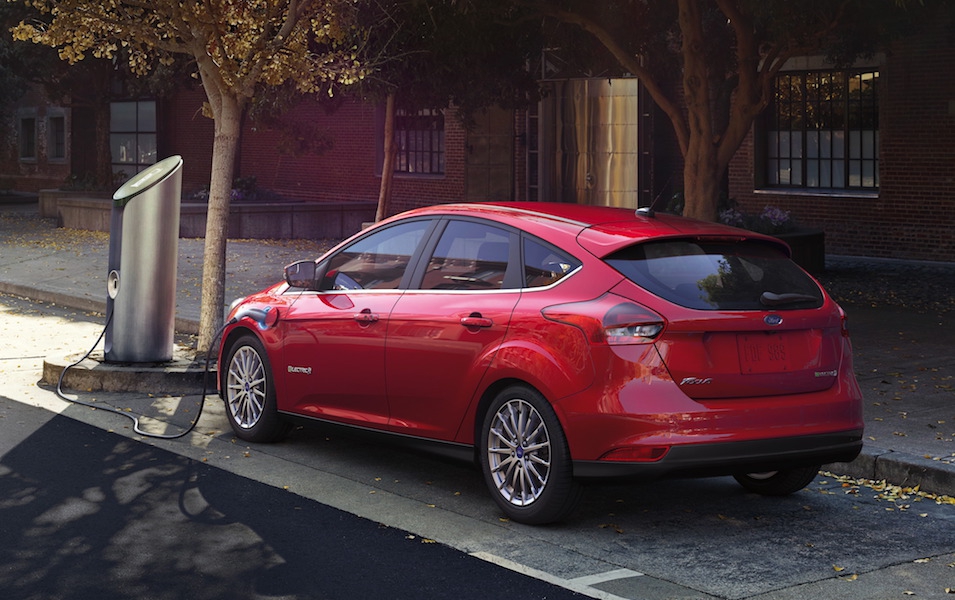
Electrified Transport
Features
Articles
Today’s electric vehicles CAN replace 90% of vehicles on the road
August 15, 2016 | By Anthony Capkun
 2016 Ford Focus Electric courtesy Ford Motor Company.
2016 Ford Focus Electric courtesy Ford Motor Company. August 15, 2016 – Despite their limited driving range, could existing electric vehicles (EVs) bring about a meaningful reduction in greenhouse gas emissions? Researchers at MIT have just completed what they’re calling “the most comprehensive study yet” to address this question, and have reached a conclusion: YES.
“Roughly 90% of the personal vehicles on the road daily could be replaced by a low-cost electric vehicle available on the market today, even if the cars can only charge overnight,” said Jessika Trancik, one of the study’s authors.
Even when accounting for the emissions from power plants as they produce the electricity EVs require, it would lead to a roughly 30% reduction in emissions from transportation.
Trancik’s team spent four years on the project, which included developing a way of integrating two datasets: one detailed set of second-by-second driving behaviour based on GPS data, and another broader, more comprehensive set of national (U.S.) data based on travel surveys. Together, the two datasets encompass millions of trips made by drivers across the States.
Ultimately, the researchers needed to understand “the distances and timing of trips, the different driving behaviours, and the ambient weather conditions,” explained graduate student Zachary Needell.
By working out formulas to integrate the different sets of information and, thereby, track one-second-resolution drive cycles, the researchers were able to demonstrate the daily energy requirements of some 90% of personal cars on the road could be met by today’s EVs with their current ranges, at an overall cost to their owners that is no greater than that of a conventional vehicle.
The team looked at once-daily charging, at home or at work, to study the adoption potential given today’s charging infrastructure.
Critics of EVs cite range anxiety as a barrier to transportation electrification, which is why, Trancik said, “Developing the concepts and mathematical models required for a testable, quantitative analysis is helpful in these situations”.
Critics also cite the price tag of some EVs, and the unavailability of charging infrastructure, but the research team finds the vast majority of cars on the road consume no more energy in a day than the battery energy capacity in affordable EVs currently available.
Vehicles such as the Ford Focus Electric (photo) or the Nissan Leaf—whose sticker prices are still higher than those of conventional cars—but whose overall lifetime costs end up being comparable because of lower maintenance and operating costs—would be adequate to meet the needs of the vast majority of American drivers.
The study cautions that, for EV ownership to rise to higher levels, the needs of drivers have to be met on all days. For days on which energy consumption is higher (e.g. road trips) or when an intensive need for heating or cooling would sharply curb the EV’s distance range, driving needs could be met by using a different car (in a two-car home), or by renting, or using a car-sharing service.
The study highlights the role the car-sharing of internal combustion engine vehicles can play in driving electrification, but it has to be convenient if it is to work. Additionally, the days on which alternatives are needed should be known to drivers in advance—information that the team’s model “TripEnergy” is able to provide.
Even as batteries improve, there will continue to be a number of high-energy days exceeding the range provided by EVs. For these days, other powertrain technologies will likely be needed. The study aims to help policy-makers quantify the “returns” to improving batteries through investing in research, for example, and the gap that will need to be filled by other kinds of cars, such as those fuelled by biofuel or hydrogen.
Another important finding from the study was that the potential for shifting to EVs is fairly uniform for different parts of the country. “The adoption potential of [EVs] is remarkably similar across cities,” Trancik said, “from dense urban areas like New York to sprawling cities like Houston. This goes against the view that electric vehicles—at least affordable ones, which have limited range—only really work in dense urban centres”.
— With files from David L. Chandler, MIT News Office. Photo of 2016 Ford Focus Electric courtesy Ford Motor Company.
Print this page